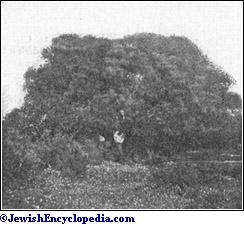Tree-Worship
 From Jewish Encyclopedia (1906)
From Jewish Encyclopedia (1906) Tree-Worship:
By: Executive Committee of the Editorial Board. , George A. Barton
- The Sacred Terebinth.
Trees have been objects of worship in all parts of the world (comp. Mannhardt, "Wald- und Feldkulte," Berlin, 1875). They were worshiped among the Semites (comp. Wellhausen, "Reste Arab. Heidentums," 2d ed., 1897, pp. 101
et seq.
; W. R. Smith, "Rel. of Sem." 2d ed., 1894, pp. 185
et seq.
; Barton, "Sketch of Semitic Origins," pp. 87
et seq.
), and the Hebrews were no exception to this. The tree that was generally regarded as sacred in Palestine was the oak, or the terebinth, which in hot countries, especially the more southerly of those about the Mediterranean, takes the place of the oak. It is called "allon," which possibly meant "divine tree" (from
 ), though another etymology is perhaps more probable. This was not the only sacred tree; for traces of the worship of the palm-tree survive (
comp. Tree of Life
), and Abraham planted an "eshel" (tamarisk) by the sacred wells at Beer-sheba and called on the name of God there (Gen. xxi. 33). Tamarisks existed also at Ramah in the time of Saul and at Jabesh in Gilead (I Sam. xxii. 6, xxxi. 13, Hebr.). It was the terebinth, however, which was generally worshiped, and the worship of which was denounced by the Prophets.
), though another etymology is perhaps more probable. This was not the only sacred tree; for traces of the worship of the palm-tree survive (
comp. Tree of Life
), and Abraham planted an "eshel" (tamarisk) by the sacred wells at Beer-sheba and called on the name of God there (Gen. xxi. 33). Tamarisks existed also at Ramah in the time of Saul and at Jabesh in Gilead (I Sam. xxii. 6, xxxi. 13, Hebr.). It was the terebinth, however, which was generally worshiped, and the worship of which was denounced by the Prophets.

The worship of this tree is connected with the earliest traditions. At Shechem,
The sacred character of many of these trees has survived to the present time. There is, for example, one on Jabal Ausha', and others are at 'Ain Yajuz and Suf (comp. Barton in "Biblical World," 1904, xxiv. 170, 174; idem , "A Year's Wandering in Bible Lands," 1904, p. 162). The one at Suf is thickly hung with rags. In southern Gilead to-day the limbs of the ordinary terebinth are cut for fire-wood, so that the tops of the trees are kept small and are much misshapen. The sacred ones, on the contrary, are left intact and cast a fine shade. Perhaps this was the case in ancient times also. If so, it would explain the phrase "green tree" as applied to those which were sacred.
Other trees besides those mentioned may have had a sacred character, as is suggested by the fact that David once received an oracle through the mulberry-or balsam-tree ("baka"; comp. II Sam. v. 24); but nearly all trace of such a character has disappeared. As has been pointed out, the Prophets were unable completely to suppress tree-worship, which has survived in Palestine through all religious changes to the present day.
- In addition to the works mentioned, see Baudissin, Studien, vol. ii.;
- Jacobs, Studies in Biblical Archœology, pp. 68-74.
Categories: [Jewish encyclopedia 1906]
↧ Download as ZWI file | Last modified: 09/04/2022 17:36:59 | 22 views
☰ Source: https://www.jewishencyclopedia.com/articles/14493-tree-worship.html | License: Public domain
 ZWI signed:
ZWI signed: KSF
KSF